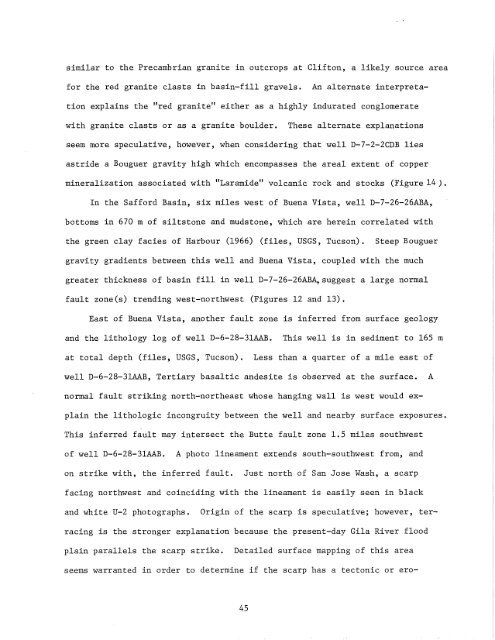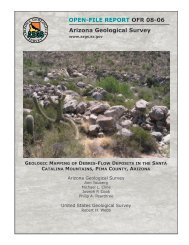geothermal resource potential of the safford-san simon basin, arizona
geothermal resource potential of the safford-san simon basin, arizona
geothermal resource potential of the safford-san simon basin, arizona
You also want an ePaper? Increase the reach of your titles
YUMPU automatically turns print PDFs into web optimized ePapers that Google loves.
similar to <strong>the</strong> Precambrian granite in outcrops at Clifton, a likely source area<br />
for <strong>the</strong> red granite clasts in <strong>basin</strong>-fill gravels.<br />
An alternate interpretation<br />
explains <strong>the</strong> "red granite" ei<strong>the</strong>r as a highly indurated conglomerate<br />
with granite clasts or as a granite boulder.<br />
These alternate explanations<br />
seem more speculative, however, when considering that well D-7-2-2CDB lies<br />
astride a Bouguer gravity high which encompasses <strong>the</strong> areal extent <strong>of</strong> copper<br />
mineralization associated with "Laramide" volcanic rock and stocks (Figure 14 ) .<br />
In <strong>the</strong> Safford Basin, six miles west <strong>of</strong> Buena Vista, well D-7-26-26ABA,<br />
bottoms in 670 m <strong>of</strong> siltstone and mudstone, which are herein correlated with<br />
<strong>the</strong> green clay facies <strong>of</strong> Harbour (1966) (files, USGS, Tucson). Steep Bouguer<br />
gravity gradients between this well and Buena Vista, coupled with <strong>the</strong> much<br />
greater thickness <strong>of</strong> <strong>basin</strong> fill in well D-7-26-26AB~suggesta large normal<br />
fault zone(s) trending west-northwest (Figures 12 and 13).<br />
East <strong>of</strong> Buena Vista, ano<strong>the</strong>r fault zone is inferred from surface geology<br />
and <strong>the</strong> lithology log <strong>of</strong> well D-6-28-3lAAB.<br />
This well is in sediment to 165 m<br />
at total depth (files, USGS, Tucson). Less than a quarter <strong>of</strong> a mile east <strong>of</strong><br />
well D-6-28-3lAAB, Tertiary basaltic andesite is observed at <strong>the</strong> surface.<br />
A<br />
normal fault striking north-nor<strong>the</strong>ast whose hanging wall is west would explain<br />
<strong>the</strong> lithologic incongruity between <strong>the</strong> well and nearby surface exposures.<br />
This inferred fault may intersect <strong>the</strong> Butte fault zone 1.5 miles southwest<br />
<strong>of</strong> well D-6-28-3lAAB. A photo lineament extends south-southwest from, and<br />
on strike with, <strong>the</strong> inferred fault.<br />
Just north <strong>of</strong> San Jose Wash, a scarp<br />
facing northwest and coinciding with <strong>the</strong> lineament is easily seen in black<br />
and white U-2 photographs.<br />
Origin <strong>of</strong> <strong>the</strong> scarp is speculative; however, terracing<br />
is <strong>the</strong> stronger explanation because <strong>the</strong> present-day Gila River flood<br />
plain parallels <strong>the</strong> scarp strike.<br />
Detailed surface mapping <strong>of</strong> this area<br />
seems warranted in order to determine if <strong>the</strong> scarp has a tectonic or ero-<br />
45

















